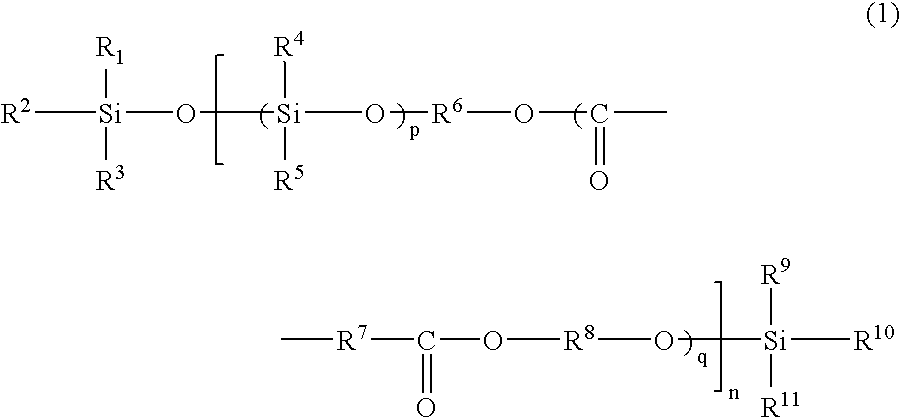Flame-retardant biodegradable material and manufacturing method of the same, flame-retardant biodegradable polymeric composition, and molded product and disposal method of the same
- Summary
- Abstract
- Description
- Claims
- Application Information
AI Technical Summary
Benefits of technology
Problems solved by technology
Method used
Image
Examples
example 1
[0062] In this example, as a compound represented by general formula (2), a compound where R1, R2, R3, R4, and R5 are methyl groups, R6 is an ethylene group, and p is 4 (hereinafter referred to as compound (2-1)) is used. As a compound represented by general formula (3), a compound where R7 is a butylene group and R12 and R13 are hydrogen atoms (hereinafter referred to as compound (3-1)) is used. As a compound represented by general formula (4), a compound where R8 is a butylene group (hereinafter referred to as compound (4-1)) is used. Furthermore, as a compound represented by general formula (5), a compound where R8 is a butylene group and R9, R10, and R11 are methyl groups (hereinafter referred to as compound (5-1)) is used.
[0063] Five weight parts of the above-described compound (2-1), one weight part of compound (3-1), one weight part of compound (4-1), and one weight part of compound (5-1) are placed in a three-necked flask and 0.002 weight part of calcium acetate is added to...
example 2
[0072] First, polymer (III-1) is synthesized similarly to Example 1.
[0073] Subsequently, four weight parts of polymer (III-1) and 96 weight parts of polybutylene succinate / adipate (manufactured by Showa Kobunshi Co., BIONOLE #2000) are placed in a kneader (produced by Technobel Co., Model KZW15-45MG) and underwent melt kneading at 260° C. to prepare pellets.
[0074] The pellets underwent injection molding through an injection molding machine (produced Yamashiro Seiki Co.) at a melt temperature of 270° C. to prepare 1A type test specimens as described in JIS K-7162, 1A type test specimens stipulated by JIS-K-7110, and test specimens for flame resistance test of 100×200 mm in width and length and 3.18 mm in thickness.
[0075] About the respective test specimens thus prepared, the tensile break strength, Izod impact strength, self-extinguishing properties, and biodegradability are evaluated similarly to Example 1. Results are shown in Table 5.
example 3
[0076] First, polymer (III-1) is synthesized similarly to example 1.
[0077] Subsequently, three weight parts of polymer (III-1) and 97 weight parts of polyethylene terephthalate (manufactured by E.I. du Pont de Nemours Co., Biomax WB100) are placed in a kneader (produced by Technobel Co., Model KZW15-45MG) and underwent melt kneading at 280° C. to prepare pellets.
[0078] The pellets underwent injection molding through an injection molding machine (produced by Yamashiro Seiki Co.) at a melt temperature of 290° C. to prepare 1A type test specimens as described in JIS K-7162, 1A type test specimens stipulated by JIS K-7110, and test specimens for flame resistance test of 100×200 mm in width and length and 3.18 mm in thickness.
[0079] About the respective specimens thus prepared, the tensile break strength, Izod impact strength, self-extinguishing properties, biodegradability are evaluated similarly to Example 1. Results are shown in Table 5.
PUM
| Property | Measurement | Unit |
|---|---|---|
| Volume | aaaaa | aaaaa |
| Volume | aaaaa | aaaaa |
| Volume | aaaaa | aaaaa |
Abstract
Description
Claims
Application Information
 Login to View More
Login to View More - R&D
- Intellectual Property
- Life Sciences
- Materials
- Tech Scout
- Unparalleled Data Quality
- Higher Quality Content
- 60% Fewer Hallucinations
Browse by: Latest US Patents, China's latest patents, Technical Efficacy Thesaurus, Application Domain, Technology Topic, Popular Technical Reports.
© 2025 PatSnap. All rights reserved.Legal|Privacy policy|Modern Slavery Act Transparency Statement|Sitemap|About US| Contact US: help@patsnap.com



